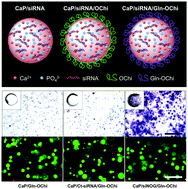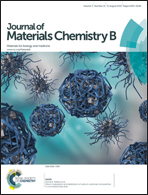Glutamine-chitosan modified calcium phosphate nanoparticles for efficient siRNA delivery and osteogenic differentiation†
Abstract
RNA interference (RNAi)-based therapy using small interfering RNA (siRNA) exhibits great potential to treat diseases. Although calcium phosphate (CaP)-based systems are attractive options to deliver nucleic acids due to their good biocompatibility and high affinity with nucleic acids, they are limited by uncontrollable particle formation and inconsistent transfection efficiencies. In this study, we developed a stable CaP nanocarrier system with enhanced intracellular uptake by adding highly cationic, glutamine-conjugated oligochitosan (Gln-OChi). CaP nanoparticles coated with Gln-OChi (CaP/Gln-OChi) significantly enhanced gene transfection and knockdown efficiency in both immortalized cell line (HeLa) and primary mesenchymal stem cells (MSCs) with minimal cytotoxicity. The osteogenic bioactivity of siRNA-loaded CaP/Gln-OChi particles was further confirmed in three-dimensional environments by using photocrosslinkable chitosan hydrogels encapsulating MSCs and particles loaded with siRNA targeting noggin, a bone morphogenetic protein antagonist. These findings suggest that our CaP/Gln-OChi nanocarrier provides an efficient and safe gene delivery system for therapeutic applications.


 Please wait while we load your content...
Please wait while we load your content...